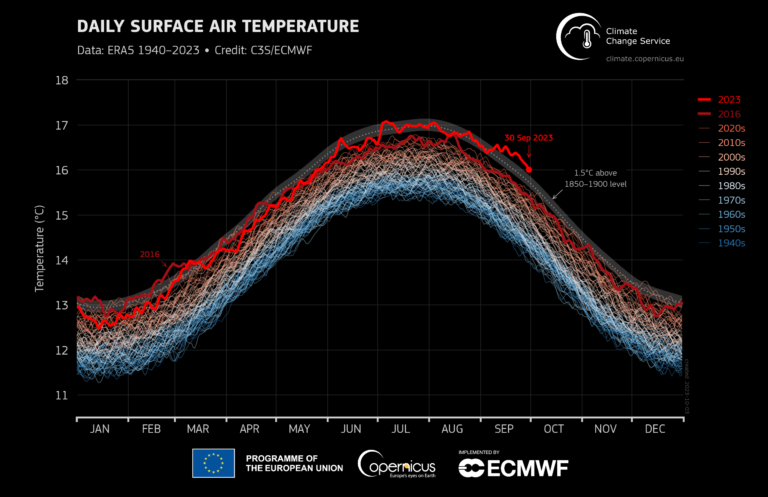The Copernicus Climate Change Service (C3S) has released its September climate bulletin reporting on the changes observed in global surface air temperature, sea ice cover and hydrological variables. All the reported findings are based on computer-generated analyses using billions of measurements from satellites, ships, aircraft and weather stations around the world.
The surface air temperature and sea surface temperature highlights included the observation that September 2023 was the warmest September on record globally, with an average surface air temperature of 16.38°C, 0.93°C above the 1991-2020 average for September and 0.5°C above the temperature of the previous warmest September, in 2020. Additionally, the global temperature was the most anomalous warm month of any year in the ERA5 data set (back to 1940). The month as a whole was around 1.75°C warmer than the September average for 1850-1900, the preindustrial reference period.
The research found that global temperature for January-September 2023 was 0.52°C higher than average, 0.05°C higher than the equivalent period in the warmest calendar year (2016), and 1.40°C higher than the 1850-1900 average. In Europe, September 2023 was the warmest September on record, at 2.51°C higher than the 1991-2020 average, and 1.1°C higher than 2020, the previous warmest September. The average sea surface temperature for September over 60°S–60°N reached 20.92°C, the highest on record for September and the second highest across all months, behind August 2023. Additionally, El Niño conditions continued to develop over the equatorial eastern Pacific.
According to Samantha Burgess, deputy director of the Copernicus Climate Change Service (C3S), “The unprecedented temperatures for the time of year observed in September – following a record summer – have broken records by an extraordinary amount. This extreme month has put 2023 on track to be the warmest year at around 1.4°C above preindustrial average temperatures.”
Alongside this, the researchers found that Antarctic sea ice extent remained at a record low level for the time of year. Both the daily and monthly extents reached their lowest annual maxima in the satellite record in September, with the monthly extent 9% below average. The daily Arctic sea ice extent reached its sixth lowest annual minimum, while the monthly sea ice extent ranked fifth lowest, at 18% below average.
In terms of hydrological variables, September 2023 saw wetter-than-average conditions along many parts of the western seaboard of Europe, including the western Iberian Peninsula, Ireland, northern Britain and Scandinavia. It was also wetter than average in Greece, following extreme rainfall associated with storm Daniel. This event was responsible for the devastating flooding in Libya. Southern Brazil and southern Chile also experienced extreme precipitation. Drier-than-average regions included parts of Europe, southeastern USA, Mexico, central Asia and Australia, where the driest September on record was recorded.
For more on climate measurement, please click here.



